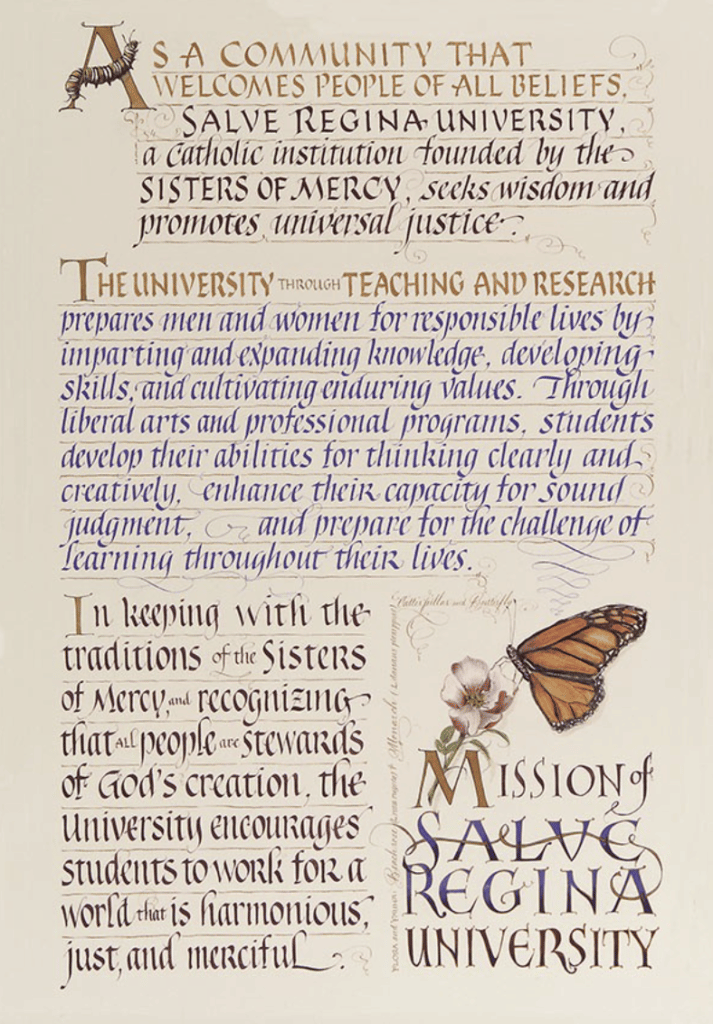By: Thomas Langan | Staff Writer
By now, most of us have seen at least the first Karate Kid film. The 1984 hit brought martial arts into popular culture in the U.S. in a way that Bruce Lee’s films had only scratched the surface of in the 1960s and 70s with pictures like Enter the Dragon. From the iconic (while ludicrous) crane kick to the “wax-on, wax-off” quote, the film brings up nostalgia not only for older viewers, but to younger audiences as well due to the popularity of the Youtube Original turned Netflix series, Cobra Kai.
Meanwhile, here at Salve we spend time and resources talking about the Mercy Mission. The Mercy Mission, while somewhat ambiguous, brings up a lot of images for many of us. For some, religious figures like the Sisters of Mercy themselves come to mind. For others, it’s community work or other acts of compassion. Crane kicks and car waxing likely aren’t among these images for most of us, but thematically, these films actually align surprisingly well with Salve’s Mercy Mission.
Starting with the original film, most of the thematic material in the movie comes from the ever-wise mouth of Mr. Miyagi, who trains Daniel Larusso in Okinawan karate. One of his big refrains in the movie is that karate should be used for defense only. This in itself shows a certain amount of mercy. A person with the skill to hurt others (in the context of a movie, without consequences), but who chooses to display self-control, is showing a kind of mercy to the other person. Empathy prevails over physical domination. Mr. Miyagi also shows mercy to Daniel by healing his injuries, fixing his damaged bike, and teaching him how to defend himself. Daniel never would have been able to win the tournament without Mr. Miyagi’s mercy, and the narrative of the film pushes this as one of its main ideas.
This narrative thruline continues right into the second film. In the very first scene, the antithesis to Mr. Miyagi, John Kreese, abuses his student Johnny Lawrence for coming second in the tournament to Daniel. Miyagi steps in freeing Johnny from Kreese’s headlock and easily defeats Kreese without throwing a single technique. Just when Miyagi could have exercised his wrath on Kreese (and justifiably so) he simply lets him go. Importantly, before he does so he sardonically parrots Kreese’s mantra of “the enemy deserves no mercy.” This key scene illustrates how big a role mercy plays in the thematic material of these films. To further prove the point, the final fight of the film between Daniel and Chozen ends in exactly the same way, with Daniel mirroring Miyagi’s move to show mercy to his opponent despite his heinous actions beforehand.

The third film pivots away from this theme of mercy to the enemy, introducing some 90s action villains so absurdly evil that the movie couldn’t possibly justify showing them mercy. Instead, The Karate Kid Part III focuses on the idea of mercy to the self. The character of Terry Silver is introduced as a kind of gateway for Daniel to go down a dark path, slowly encouraging him to harm himself in the name of his training. Daniel goes down this path for a while, but his life only worsens as a result despite his improved skills. Eventually, using the discipline of kata, he finds a peace with himself that allows him to win his final fight. It is less about showing sympathy for the infuriating Mike Barnes and more about Daniel learning to be merciful to himself and fight with a peaceful mind instead of anger.
Like the rest of the world, I’m going to ignore both the fourth movie and the Jayden Smith remake and move right along to Cobra Kai.
This series, rather than simply following in the footsteps of the first two movies and going with the idea of a wise master teaching mercy for one’s enemies to his student, smartly subverts the trope and shows us a still immature Johnny Lawrence trying to teach a small group of students the way he was taught, and slowly learning that “no mercy” is a bad policy. The main theme is about settling old differences, as both Johnny and Daniel learn to trust and respect the people they struggled with as teenagers. Except Terry Silver. He’s still a cartoon.
So, as we emerge from our marathon of punching, kicking, and 80s nostalgia, we as Salve students can actually learn a lot from these films about how to apply the Mercy Mission to our own lives. We should show mercy to those who vex us, even when we would be justified not doing so. We should show mercy to ourselves in dark times. We should always leave the door open to show mercy to those who we have struggled with in the past. Even if we don’t have Mr. Miyagi guiding us, we have a pretty good road map to go on.
Photo by Charlein Gracia on unsplash.com














